人教版高中英语必修4 Unit 4 Body Language Reading I 课件(共49张PPT)
文档属性
| 名称 | 人教版高中英语必修4 Unit 4 Body Language Reading I 课件(共49张PPT) | 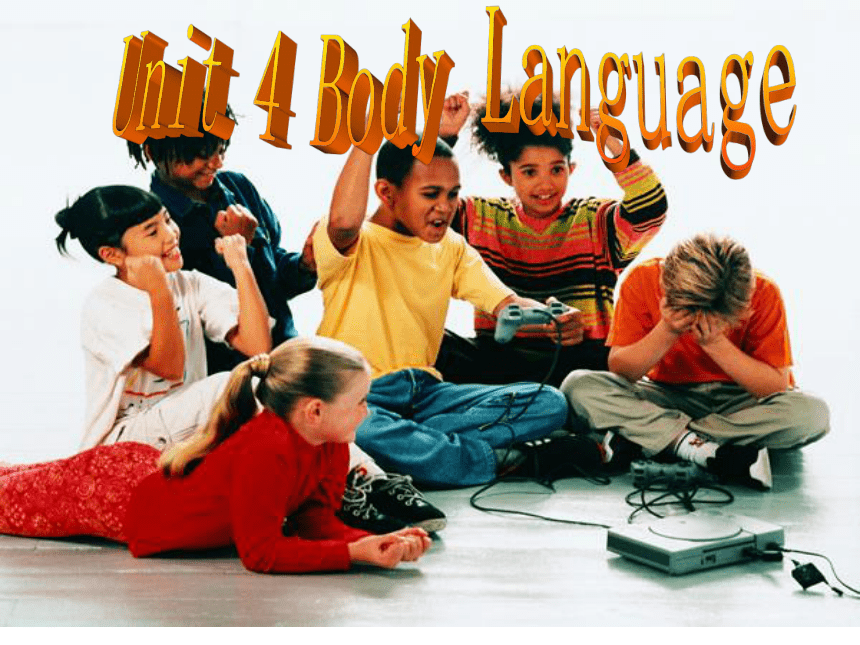 | |
| 格式 | zip | ||
| 文件大小 | 1.6MB | ||
| 资源类型 | 教案 | ||
| 版本资源 | 人教版(新课程标准) | ||
| 科目 | 英语 | ||
| 更新时间 | 2019-04-12 08:45:28 | ||
图片预览

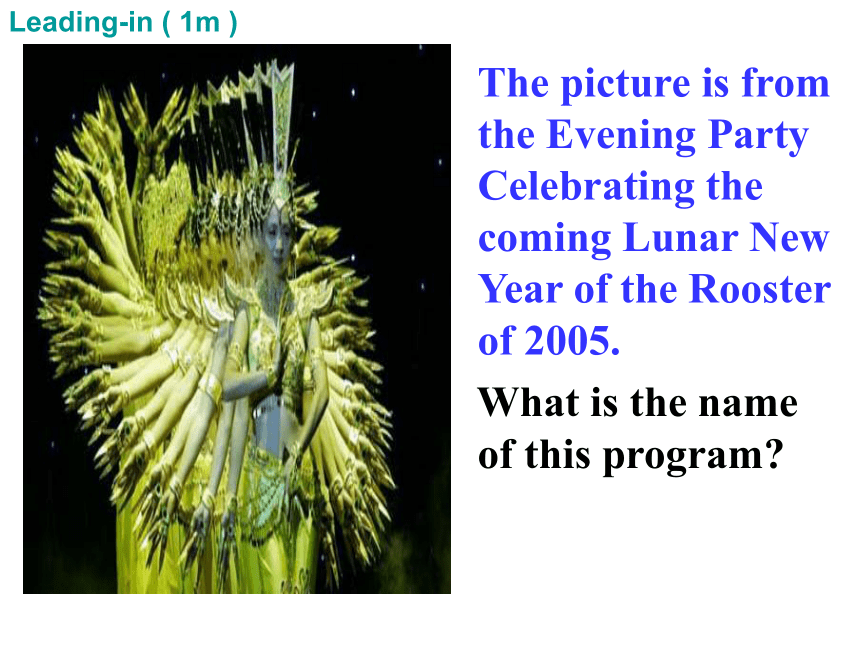
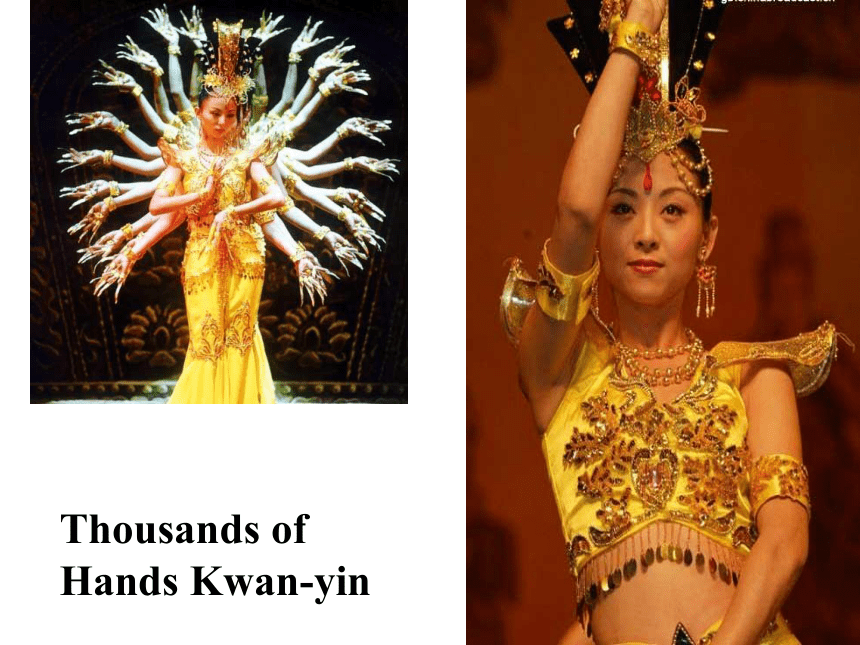
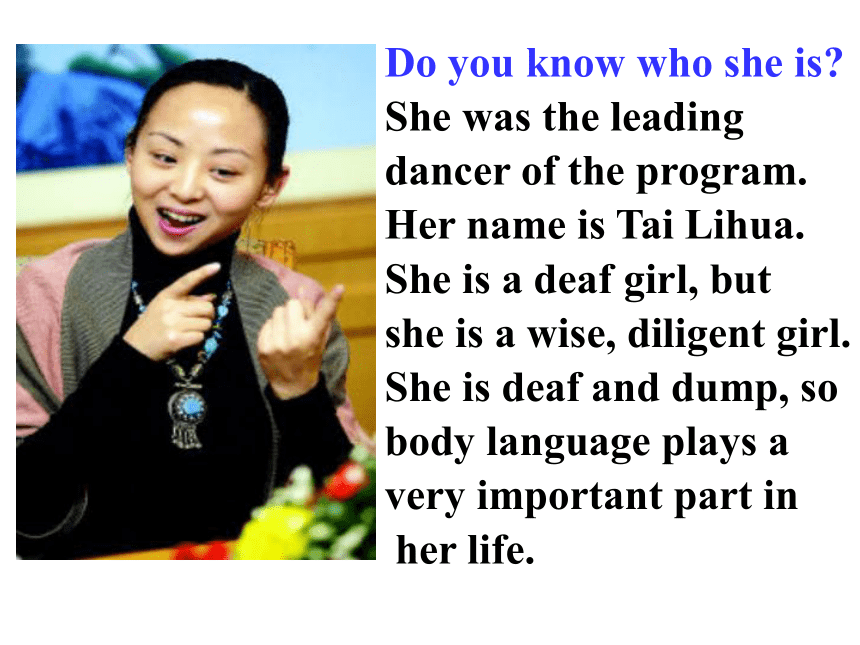

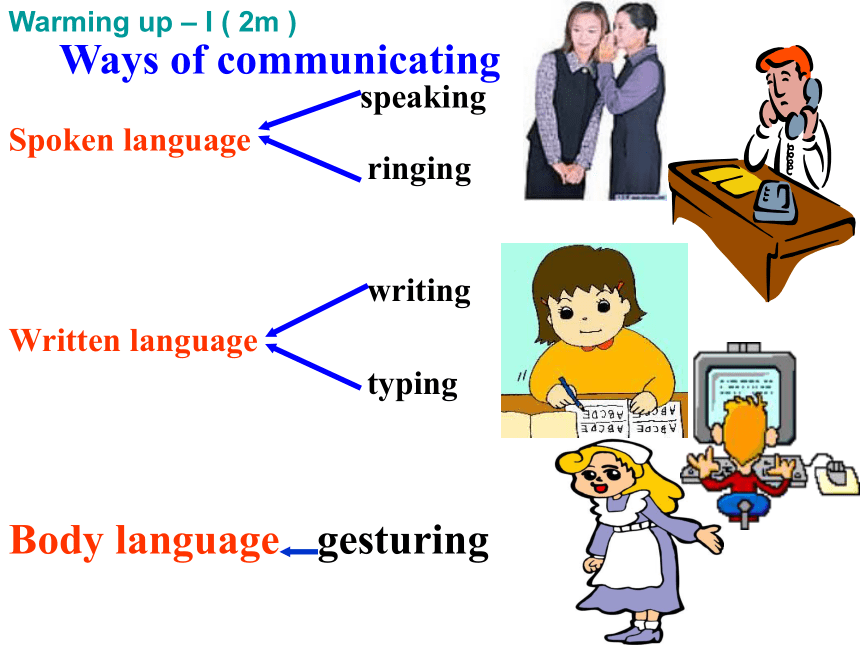
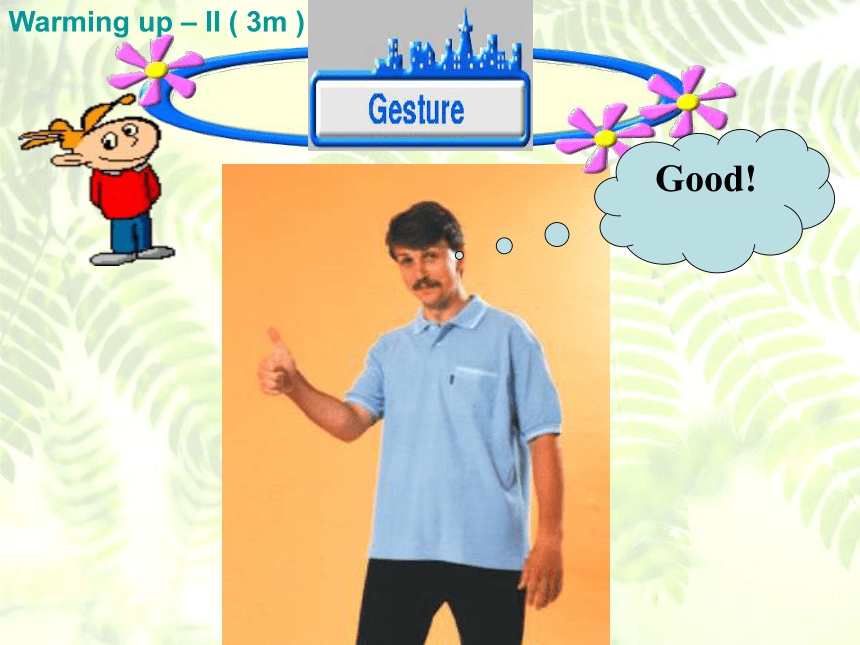
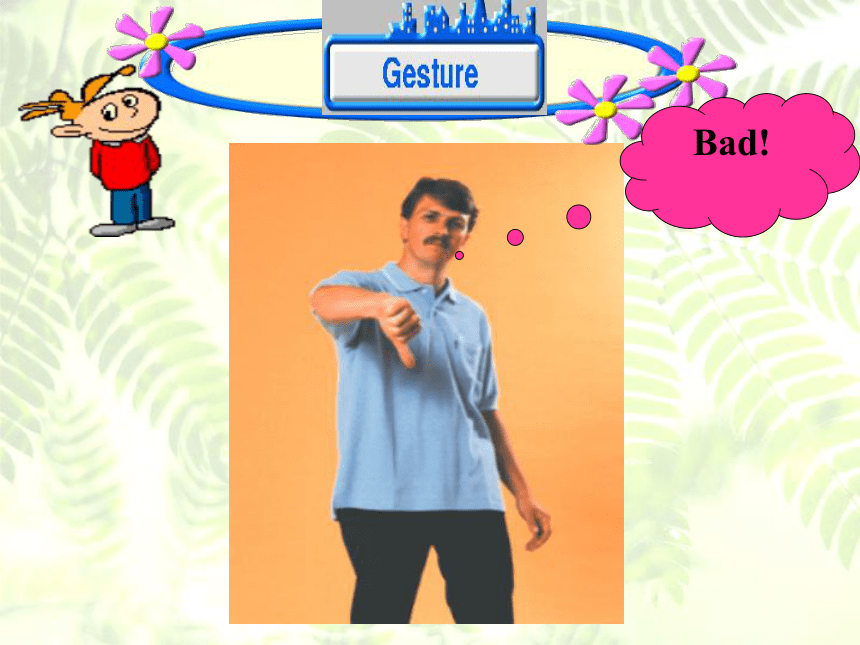
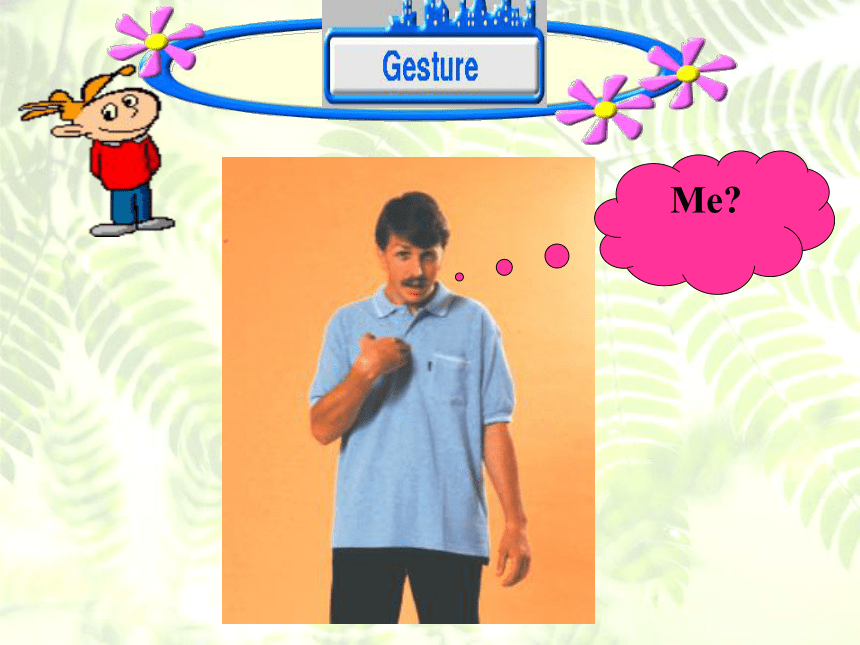
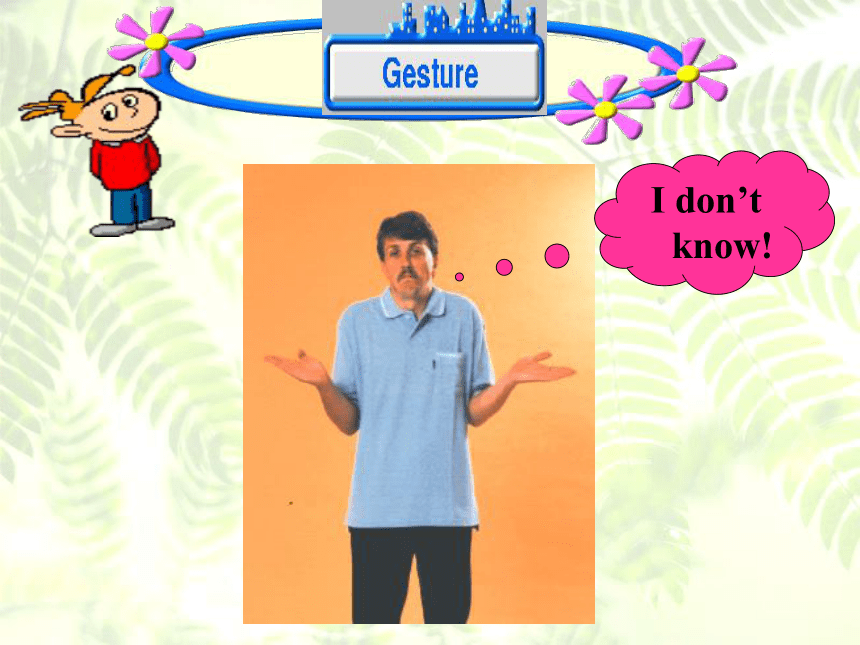
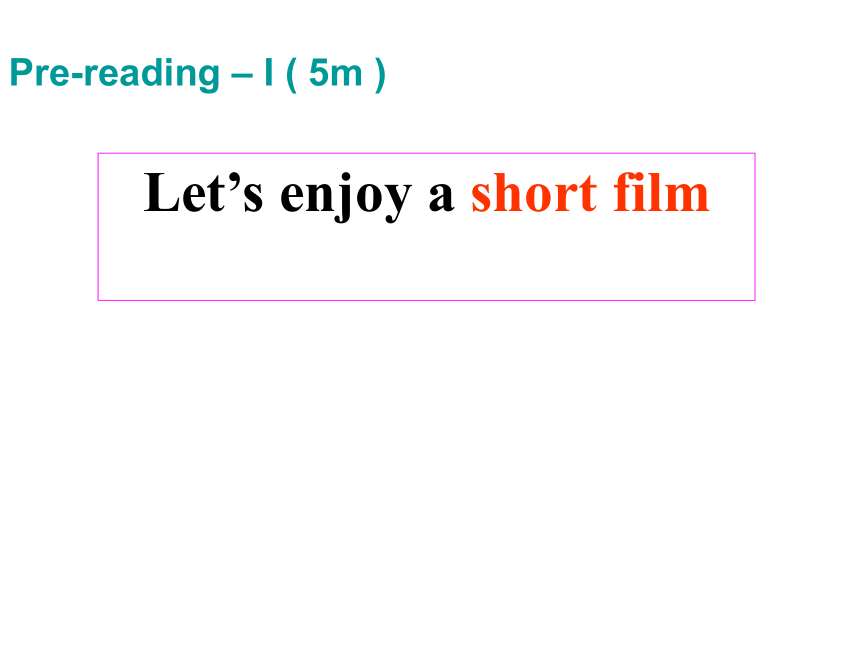

文档简介
课件49张PPT。Unit 4 Body Language The picture is from the Evening Party Celebrating the coming Lunar New Year of the Rooster of 2005.
What is the name of this program?
Leading-in ( 1m ) Thousands of Hands Kwan-yinDo you know who she is?
She was the leading
dancer of the program.
Her name is Tai Lihua.
She is a deaf girl, but
she is a wise, diligent girl.
She is deaf and dump, so
body language plays a
very important part in
her life. What do you think is the
purpose of language?To communicate with
each other.speakingringingwritingtypingSpoken languageWritten languageBody languageWays of communicating gesturingWarming up – I ( 2m ) GuessGood!
Warming up – II ( 3m )GuessBad!
GuessMe?
GuessI don’t know!
Let’s enjoy a short film
Pre-reading – I ( 5m )1. Who is the funny man in the film?2. Do the actors say anything in the show?3. How do they express themselves?4. What do you call that?Charlie Chaplin.No, nothing.By what they do and their facial expressions.Body language.Definition for Body LanguageWhat is body language?Body language is one form of communication, communication without _____________. Eye contact (眼部交流)or ___________, _________, and__________, or the ways you stand, are different kinds of body language.
saying wordsfacial expressionsgesturesposturesEye contactFacial expressionGesturePostureWell-doneOk stopquietGesturesvictory!
I am thinkingpick –up 搭便车 joyangersurprisesorrowFacial expressionsLooking down uponPosture handshake Kiss hugshake nodbow blow a kiss.Do people all over the world act the same?Go on enjoy body languages.Reading P25Reading Communication:
No problem? Mr. Garcia (Columbia)Julia Smith (Britain)
George Cook (Canada)a JapaneseFirst reading :try to find out the main idea of the text. Which is the main idea of the text?
A. There are different customs in
different countries.
B. Foreigners should follow the
customs of the country where they
are visiting.
C. People use body movements to send
messages and different body
movements have different meanings.
D. The importance of knowing customs. (Para.1)(Para.2~3)(Para.4)(Para.5)Different people have different body language. Examples of learned or cultural “body language”.You are sent to CIA to meet business people. Summary of body language. Match the main idea of each part with lines.Part 1. Part 2. Part 3. Part 4. Fast Reading How do different international students behave when they greet people? Complete the chart with information from the passage.man from
Colombiakiss on the
cheekbowingeveryoneeveryoneJulia
SmithAkira
Nagatawoman from
Britainman from
Canadashaking
handsshaking
hands
noddingAhmed
AzizDarlene
Coulonman from
Jordaneveryonewoman
from France people she
knows Read paragraph3-5, then decide if the following statements are true (T) or false (F) and correct the error.TFT FEnglishmen often stand close to others or touch strangers as soon as they meet.
The author of this passage is female and she doesn’t
like touching another person.
Japanese will bow to others as greeting.
People from Jordan will move very close to you as you introduce yourself to them.
Some body languages in some countries are good while some countries’ body language are bad.FReading 1.2.3.4.5.Read the passage again and then answer the following questions:Reading A. descriptive(描述性的)
B. narrative(叙事的)
C. argumentative(议论的)
D. expositive(说明的)
1.What type of writing is the text2. What can we infer from the text ?
A. A boy from Spain is likely to touch the people
he meets.
B. Physical distance can’t send out a message.
C. English people may stand very close to their
friends.
D. It’s friendly to touch Muslim women.
3.From the passage we know ,most international
students greet others by -------.
A. shaking hands B. bowing
C .kissing D.touching shoulders
4.When writing the text ,the author is
A.encouraging readers to do something
B. informing readers of something
C. drawing readers attention to some western countries
D.regretting cultural difference
5. Which of the following is true ?
A. French people often greet people by kissing
each other on both cheeks.
B. All people around the world now greet
people by shaking hands.
C. People from Britain and from South
American countries seem to prefer to keep
more physical distance from others.
D. Not knowing foreign customs may cause a
cultural mistake. Read the text again and then finish the following form:Reading Approach others closely and are more likely to touch them.Shake hands, do not stand very close to others or touch strangers when they meet. BowShake hands.Shake hands and stand quite close to other men. Nod to women but do not shake hands with them.Use the passage to help you answer the
following questions.1 Is the author of this passage male or female? How do you know?
2 What were the two mistakes that the author noticed?
3 Who seemed to prefer to keep more physical distance from others? Who seemed to prefer closer physical distance? 4 Did any students have similar greeting customs? If so, which ones?
5 “ When in Rome, do as the Romans do.” What do you think this famous saying means?
6 Do you agree with the author’s statement that body language is not good or bad? Why or why not?1 Is the author of this passage male or female? How do you know?The author is male. Ahmed Aziz will not
shake hands with women, but he shakes
with the author.2 What were the two mistakes that the author noticed?He noticed that the Colombian man kissed
the British woman, but in her culture, a
kiss from a stranger is not acceptable. He
also noticed that the Japanese man bowed
just as the Canadian man started to
shake hands, so one man’s nose touched
the other man’s hand.3 Who seemed to prefer to keep more physical distance from others? Who seemed to prefer closer physical distance? The British woman, Julia, and probably the
Canadian man, George, seemed to prefer
to keep more physical distance from others.
The Colombian man, Tony, and the
Jordanian man, Ahmed, seemed to prefer
closer physical distance. 4 Did any students have similar greeting customs? If so, which ones?Yes. Tony from Colombia and Darlene
from France had a similar greeting custom
– a kiss. George from Canada and Ahmed
from Jordan also had a similar greeting
custom – a handshake, but Ahmed shakes
hands only with men.5 “ When in Rome, do as the Romans do.” What do you think this famous saying means?This saying means that when we are in
a certain place, we should follow the
customs of the people who live in that
place, not our own customs.Post-readingTask : discussionDo you think body language is important? Why?
. Don’t crowd.
Don’t stand too close
to others.
In almost all cultures ,to
smile and show an open right hand means,” Welcome, you
are safe with me”.
So next time you are sitting on a train or enjoy a party or simply walking through the town
Remember your body is always giving off signals.
Your body language never stops. Thank you
What is the name of this program?
Leading-in ( 1m ) Thousands of Hands Kwan-yinDo you know who she is?
She was the leading
dancer of the program.
Her name is Tai Lihua.
She is a deaf girl, but
she is a wise, diligent girl.
She is deaf and dump, so
body language plays a
very important part in
her life. What do you think is the
purpose of language?To communicate with
each other.speakingringingwritingtypingSpoken languageWritten languageBody languageWays of communicating gesturingWarming up – I ( 2m ) GuessGood!
Warming up – II ( 3m )GuessBad!
GuessMe?
GuessI don’t know!
Let’s enjoy a short film
Pre-reading – I ( 5m )1. Who is the funny man in the film?2. Do the actors say anything in the show?3. How do they express themselves?4. What do you call that?Charlie Chaplin.No, nothing.By what they do and their facial expressions.Body language.Definition for Body LanguageWhat is body language?Body language is one form of communication, communication without _____________. Eye contact (眼部交流)or ___________, _________, and__________, or the ways you stand, are different kinds of body language.
saying wordsfacial expressionsgesturesposturesEye contactFacial expressionGesturePostureWell-doneOk stopquietGesturesvictory!
I am thinkingpick –up 搭便车 joyangersurprisesorrowFacial expressionsLooking down uponPosture handshake Kiss hugshake nodbow blow a kiss.Do people all over the world act the same?Go on enjoy body languages.Reading P25Reading Communication:
No problem? Mr. Garcia (Columbia)Julia Smith (Britain)
George Cook (Canada)a JapaneseFirst reading :try to find out the main idea of the text. Which is the main idea of the text?
A. There are different customs in
different countries.
B. Foreigners should follow the
customs of the country where they
are visiting.
C. People use body movements to send
messages and different body
movements have different meanings.
D. The importance of knowing customs. (Para.1)(Para.2~3)(Para.4)(Para.5)Different people have different body language. Examples of learned or cultural “body language”.
Colombiakiss on the
cheekbowingeveryoneeveryoneJulia
SmithAkira
Nagatawoman from
Britainman from
Canadashaking
handsshaking
hands
noddingAhmed
AzizDarlene
Coulonman from
Jordaneveryonewoman
from France people she
knows Read paragraph3-5, then decide if the following statements are true (T) or false (F) and correct the error.TFT FEnglishmen often stand close to others or touch strangers as soon as they meet.
The author of this passage is female and she doesn’t
like touching another person.
Japanese will bow to others as greeting.
People from Jordan will move very close to you as you introduce yourself to them.
Some body languages in some countries are good while some countries’ body language are bad.FReading 1.2.3.4.5.Read the passage again and then answer the following questions:Reading A. descriptive(描述性的)
B. narrative(叙事的)
C. argumentative(议论的)
D. expositive(说明的)
1.What type of writing is the text2. What can we infer from the text ?
A. A boy from Spain is likely to touch the people
he meets.
B. Physical distance can’t send out a message.
C. English people may stand very close to their
friends.
D. It’s friendly to touch Muslim women.
3.From the passage we know ,most international
students greet others by -------.
A. shaking hands B. bowing
C .kissing D.touching shoulders
4.When writing the text ,the author is
A.encouraging readers to do something
B. informing readers of something
C. drawing readers attention to some western countries
D.regretting cultural difference
5. Which of the following is true ?
A. French people often greet people by kissing
each other on both cheeks.
B. All people around the world now greet
people by shaking hands.
C. People from Britain and from South
American countries seem to prefer to keep
more physical distance from others.
D. Not knowing foreign customs may cause a
cultural mistake. Read the text again and then finish the following form:Reading Approach others closely and are more likely to touch them.Shake hands, do not stand very close to others or touch strangers when they meet. BowShake hands.Shake hands and stand quite close to other men. Nod to women but do not shake hands with them.Use the passage to help you answer the
following questions.1 Is the author of this passage male or female? How do you know?
2 What were the two mistakes that the author noticed?
3 Who seemed to prefer to keep more physical distance from others? Who seemed to prefer closer physical distance? 4 Did any students have similar greeting customs? If so, which ones?
5 “ When in Rome, do as the Romans do.” What do you think this famous saying means?
6 Do you agree with the author’s statement that body language is not good or bad? Why or why not?1 Is the author of this passage male or female? How do you know?The author is male. Ahmed Aziz will not
shake hands with women, but he shakes
with the author.2 What were the two mistakes that the author noticed?He noticed that the Colombian man kissed
the British woman, but in her culture, a
kiss from a stranger is not acceptable. He
also noticed that the Japanese man bowed
just as the Canadian man started to
shake hands, so one man’s nose touched
the other man’s hand.3 Who seemed to prefer to keep more physical distance from others? Who seemed to prefer closer physical distance? The British woman, Julia, and probably the
Canadian man, George, seemed to prefer
to keep more physical distance from others.
The Colombian man, Tony, and the
Jordanian man, Ahmed, seemed to prefer
closer physical distance. 4 Did any students have similar greeting customs? If so, which ones?Yes. Tony from Colombia and Darlene
from France had a similar greeting custom
– a kiss. George from Canada and Ahmed
from Jordan also had a similar greeting
custom – a handshake, but Ahmed shakes
hands only with men.5 “ When in Rome, do as the Romans do.” What do you think this famous saying means?This saying means that when we are in
a certain place, we should follow the
customs of the people who live in that
place, not our own customs.Post-readingTask : discussionDo you think body language is important? Why?
. Don’t crowd.
Don’t stand too close
to others.
In almost all cultures ,to
smile and show an open right hand means,” Welcome, you
are safe with me”.
So next time you are sitting on a train or enjoy a party or simply walking through the town
Remember your body is always giving off signals.
Your body language never stops. Thank you
同课章节目录
